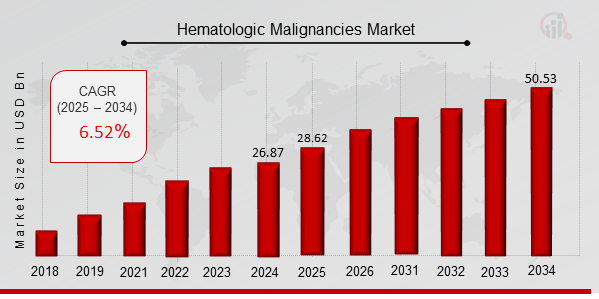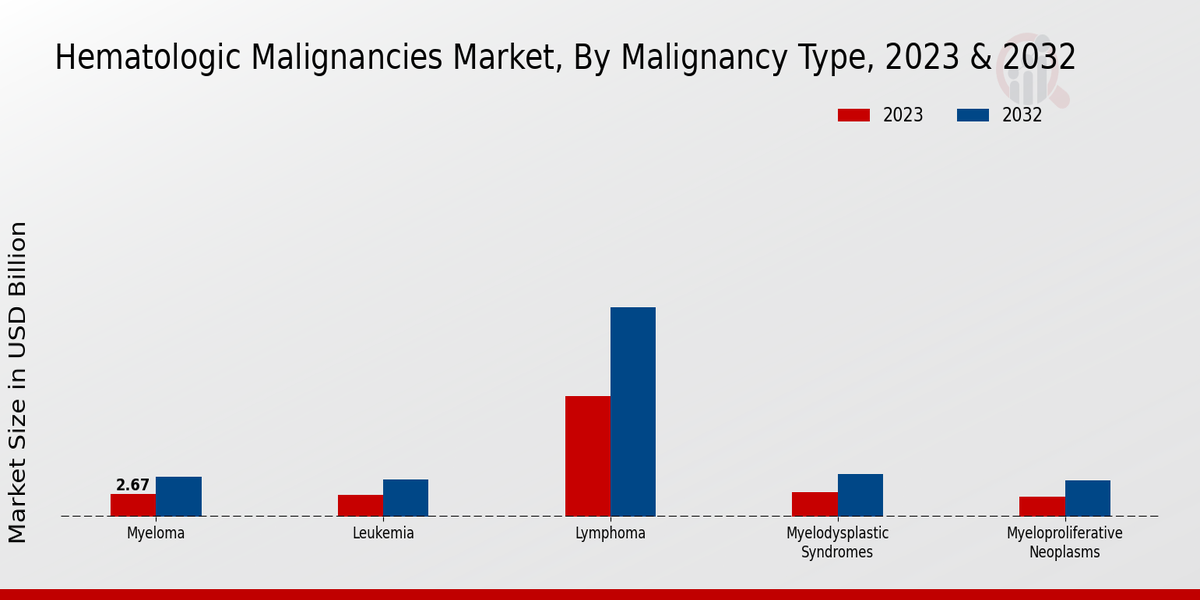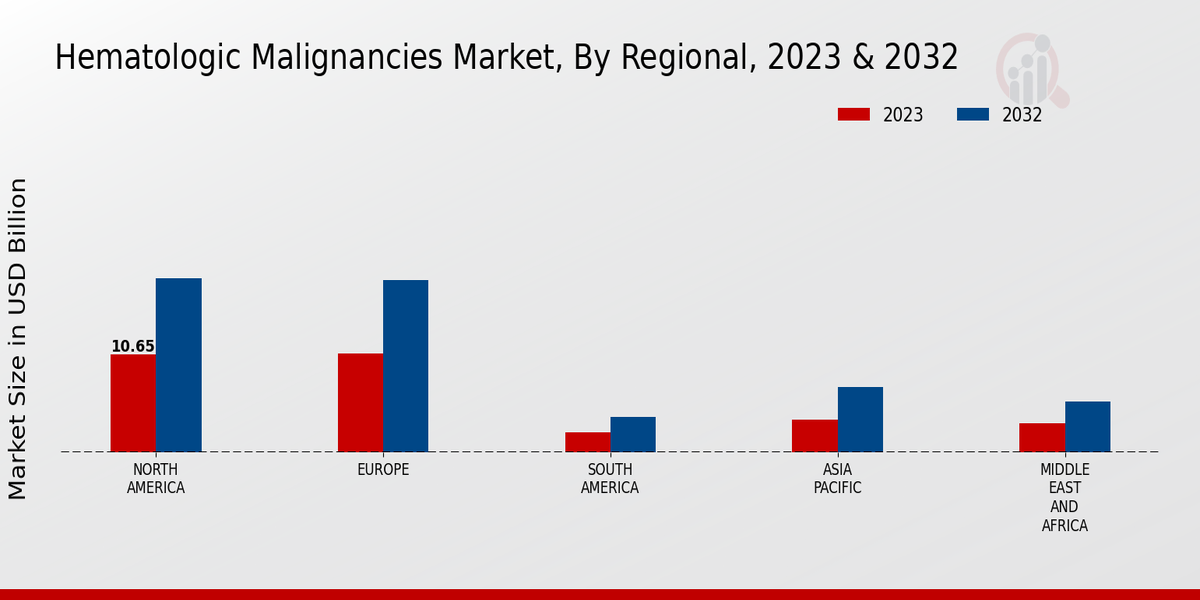Hematologic Malignancies Market Overview
As per MRFR analysis, the Hematologic Malignancies Market Size was estimated at 26.87 (USD Billion) in 2024. The Hematologic Malignancies Market Industry is expected to grow from 28.62 (USD Billion) in 2025 to 50.53 (USD Billion) till 2034, at a CAGR (growth rate) is expected to be around 6.52% during the forecast period (2025 - 2034).
Key Hematologic Malignancies Market Trends Highlighted
The global Hematologic Malignancies market has been witnessing significant advancements in recent years. Key market drivers include the increasing prevalence of blood cancers, advancements in diagnostic technologies, and the development of targeted therapies. The market is also driven by the growing demand for personalized medicine and the need for effective treatment options. Opportunities lie in the development of novel therapies, the expansion of targeted therapies, and the increasing adoption of immunotherapy. Trends in recent times include the rise of precision medicine, personalized treatment plans, and the growing use of artificial intelligence in diagnosis and treatment. With continued research and innovation, the market for Hematologic Malignancies is expected to experience further growth in the coming years.

Source: Primary Research, Secondary Research, MRFR Database and Analyst Review
Hematologic Malignancies Market Drivers
Rising Prevalence of Hematologic Malignancies
The increasing incidence of hematologic malignancies, such as leukemia, lymphoma, and myeloma, is a major driver of the global hematologic malignancies market. This rise can be attributed to factors such as the aging population, environmental pollution, and unhealthy lifestyles. As the number of individuals diagnosed with these diseases grows, the demand for diagnosis, treatment, and supportive care services also increases. This, in turn, drives the growth of the hematologic malignancies market.
Technological Advancements in Diagnosis and Treatment
The global hematologic malignancies market is also fueled by advancements in diagnostic and treatment technologies. The development of new molecular and genetic testing methods has improved the accuracy and speed of diagnosis, enabling healthcare professionals to identify and characterize hematologic malignancies more precisely. Additionally, the introduction of targeted therapies, immunotherapies, and stem cell transplantation techniques has significantly improved patient outcomes and increased the demand for these advanced treatment options.
Growing Awareness and Access to Healthcare
Increased awareness about hematologic malignancies and improved access to healthcare services are contributing to the growth of the global hematologic malignancies market. Public health campaigns and initiatives have raised awareness about the signs and symptoms of these diseases, encouraging individuals to seek medical attention sooner. Moreover, the expansion of healthcare infrastructure and insurance coverage in many regions has made it easier for patients to access timely diagnosis and treatment.
Hematologic Malignancies Market Segment Insights
Hematologic Malignancies Market Malignancy Type Insights
The Global Hematologic Malignancies Market is segmented by Malignancy Type into Leukemia, Lymphoma, Myeloma, Myelodysplastic Syndromes, and Myeloproliferative Neoplasms. Leukemia is the most common and accounts for around half of all hematologic malignancies. Lymphoma is the second most common and accounts for around 30% of cases. The rising incidence of hematologic malignancies is driving the growth of the market. Other factors contributing to the growth of the market include the increasing availability of new and more effective treatments and the growing number of patients with access to healthcare.The Leukemia segment is expected to grow at the fastest CAGR during the forecast period. This growth is attributed to the increasing incidence of leukemia and the availability of new and more effective treatments. The Lymphoma segment is also expected to grow at a significant CAGR during the forecast period.
This growth is attributed to the increasing incidence of lymphoma and the availability of new and more effective treatments. The Myeloma segment is expected to grow at a moderate CAGR during the forecast period. This growth is attributed to the increasing incidence of myeloma and the availability of new and more effective treatments.The Myelodysplastic Syndromes segment is expected to grow at a moderate CAGR during the forecast period. This growth is attributed to the increasing incidence of myelodysplastic syndromes and the availability of new and more effective treatments. The Myeloproliferative Neoplasms segment is expected to grow at a moderate CAGR during the forecast period. This growth is attributed to the increasing incidence of myeloproliferative neoplasms and the availability of new and more effective treatments.

Source: Primary Research, Secondary Research, MRFR Database and Analyst Review
Hematologic Malignancies Market Therapy Type Insights
The Global Hematologic Malignancies Market is segmented by Therapy Type into Chemotherapy, Immunotherapy, Radiation Therapy, Targeted Therapy, and Stem Cell Transplant. Chemotherapy is projected to remain the dominant segment in the market in the coming years, accounting for a revenue share of 45.2% in 2024. Immunotherapy is expected to grow at the highest CAGR during the forecast period, owing to the increasing adoption of CAR-T cell therapy and immune checkpoint inhibitors. Targeted therapy is also expected to witness significant growth, driven by the development of novel targeted drugs for hematologic malignancies.Stem Cell Transplant is expected to account for a smaller share of the market, but it remains an important treatment option for certain types of hematologic malignancies.
Hematologic Malignancies Market Treatment Line Insights
The Global Hematologic Malignancies Market is segmented based on Treatment Line into First Line, Second Line, Third Line or Later, and Maintenance Therapy. Among these, the First Line segment held the largest market share in 2023 and is expected to continue its dominance throughout the forecast period. The growth of this segment can be attributed to the increasing incidence of hematologic malignancies and the availability of novel therapies for first-line treatment. The Second Line segment is also expected to witness significant growth over the forecast period due to the rising number of patients with relapsed or refractory hematologic malignancies.The Third Line or Later segment is expected to grow at a moderate pace, while the Maintenance Therapy segment is expected to witness a steady growth rate over the forecast period.
Hematologic Malignancies Market Regional Insights
North America accounted for the largest share, 45%, in the global hematologic malignancies market in 2023 and is projected to maintain its dominance over the forecast period. The high prevalence of hematologic malignancies, the presence of well-developed healthcare infrastructure, and the availability of advanced treatment options are some of the key factors driving the growth of the market in this region. The market in Europe is expected to grow at a CAGR of 6.2% during the forecast period, owing to the rising incidence of hematologic malignancies and the increasing adoption of targeted therapies.The APAC market is projected to witness the fastest growth during the forecast period, with a CAGR of 7.5%. This growth is attributed to the increasing healthcare expenditure, the rising awareness about hematologic malignancies, and the growing number of diagnostic centers in the region.

Source: Primary Research, Secondary Research, MRFR Database and Analyst Review
Hematologic Malignancies Market Key Players And Competitive Insights
Major players in the Hematologic Malignancies Market are driving the market's growth by collaborating on research and development activities. Key market participants are aiming to strengthen their position in the global market by introducing innovative technologies and expanding their global reach. This dynamic competitive landscape is expected to continue in the coming years, shaping the overall Hematologic Malignancies Market industry. Leading Hematologic Malignancies Market players are focusing on expanding their product portfolios, geographical presence, and collaborations to maintain their competitive edge. The Hematologic Malignancies Market development is anticipated to be influenced by factors such as increased research and development efforts, favorable government initiatives, and the rising prevalence of hematologic malignancies around the world.Amgen Inc. is a prominent player in the Hematologic Malignancies Market that has made significant contributions to the healthcare sector.
The company has a long history of innovation and research and has developed a robust portfolio of treatments for hematologic malignancies. Amgen Inc. is committed to providing patients with access to high-quality healthcare and has established itself as a leader in the biotechnology industry. With its focus on innovation, collaboration, and patient-centricity, Amgen Inc. is well-positioned to continue driving advancements in the Hematologic Malignancies Market.Roche Holding AG is another leading player in the Hematologic Malignancies Market that has gained recognition for its research and development efforts. The company's commitment to innovation has led to the development of groundbreaking treatments for hematologic malignancies. Roche Holding AG has a comprehensive portfolio of products that address various types of hematologic malignancies, and the company is continuously investing in research to develop new therapies. Through collaborations with healthcare providers and research institutions, Roche Holding AG aims to improve patient outcomes and advance the field of hematologic malignancies.
Key Companies in the Hematologic Malignancies Market Include
- Merck
- Astellas Pharma
- Amgen
- AstraZeneca
- Celgene
- Takeda Pharmaceutical
- BeiGene
- Sanofi
- Roche
- Incyte
- Novartis
- AbbVie
- Janssen Pharmaceuticals
- Pfizer
- Bayer
Hematologic Malignancies Market Industry Developments
The Hematologic Malignancies Market is poised to expand significantly, with a projected valuation of USD 41.7 billion by 2032, exhibiting a CAGR of 6.5% from 2024 to 2032. This growth is attributed to advancements in targeted therapies, the increasing prevalence of hematologic malignancies, and the growing geriatric population. Key recent developments include the FDA approval of CAR T-cell therapies for B-cell lymphomas and the emergence of novel immunotherapies. Strategic collaborations and acquisitions among market players are also shaping the competitive landscape.
Hematologic Malignancies Market Segmentation Insights
Hematologic Malignancies Market Malignancy Type Outlook
- Leukemia
- Lymphoma
- Myeloma
- Myelodysplastic Syndromes
- Myeloproliferative Neoplasms
Hematologic Malignancies Market Therapy Type Outlook
- Chemotherapy
- Immunotherapy
- Radiation Therapy
- Targeted Therapy
- Stem Cell Transplant
Hematologic Malignancies Market Treatment Line Outlook
- First Line
- Second Line
- Third Line or Later
- Maintenance Therapy
Hematologic Malignancies Market Regional Outlook
- North America
- Europe
- South America
- Asia Pacific
- Middle East and Africa
| Report Attribute/Metric |
Details |
|
Market Size 2024
|
26.87 (USD Billion)
|
|
Market Size 2025
|
28.62 (USD Billion)
|
|
Market Size 2034
|
50.53 (USD Billion)
|
|
Compound Annual Growth Rate (CAGR)
|
6.52 % (2025 - 2034)
|
|
Report Coverage
|
Revenue Forecast, Competitive Landscape, Growth Factors, and Trends
|
|
Base Year
|
2024
|
|
Market Forecast Period
|
2025 - 2034
|
|
Historical Data
|
2020 - 2024
|
| Market Forecast Units |
USD Billion |
| Key Companies Profiled |
Merck, Astellas Pharma, Amgen, AstraZeneca, Celgene, Takeda Pharmaceutical, BeiGene, Sanofi, Roche, Incyte, Novartis, AbbVie, Janssen Pharmaceuticals, Pfizer, Bayer |
| Segments Covered |
Malignancy Type, Therapy Type, Treatment Line, Regional |
| Key Market Opportunities |
Novel immunotherapies Targeted therapies Precision medicine |
| Key Market Dynamics |
Rising incidence Advancements in therapy Growing geriatric population Increasing healthcare expenditure Technological advancements |
| Countries Covered |
North America, Europe, APAC, South America, MEA |
Frequently Asked Questions (FAQ) :
The global Hematologic Malignancies Market size is estimated to be worth USD 23.67 billion in 2023 and is projected to grow at a CAGR of 6.5% from 2025 to 2034, reaching a value of USD 50.53 billion by 2034
The growth of the market is driven by the increasing prevalence of hematologic malignancies, rising awareness of advanced treatment options, growing demand for targeted therapies, and supportive government initiatives.
North America is expected to hold the largest share of the market due to high healthcare expenditure, the presence of key market players, and advanced healthcare infrastructure.
Major applications of Hematologic Malignancies treatment include leukemia, lymphoma, and myeloma.
Key competitors in the Hematologic Malignancies Market include Johnson & Johnson, Bristol-Myers Squibb, F. Hoffmann-La Roche, AbbVie, and Amgen.
The Hematologic Malignancies Market is projected to grow at a CAGR of 6.52% during the forecast period from 2025 to 2034.
Challenges faced by the market include the high cost of treatment, lack of access to advanced healthcare facilities in developing countries, and stringent regulatory policies.
Key trends in the market include increasing adoption of precision medicine, growing focus on personalized treatment, and rising demand for minimally invasive procedures.
Technological advancements such as CAR T-cell therapy and gene editing are revolutionizing the treatment landscape and driving market growth.
Opportunities for growth include expanding access to treatment in underserved regions, the development of novel therapies, and increasing awareness of early detection and prevention strategies.

















